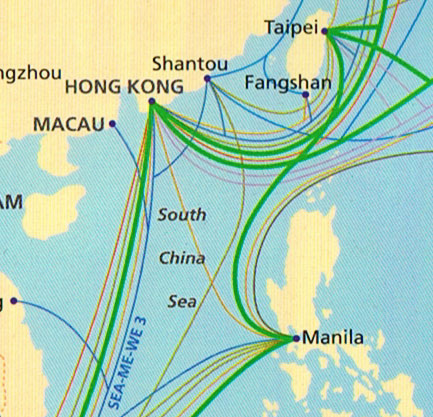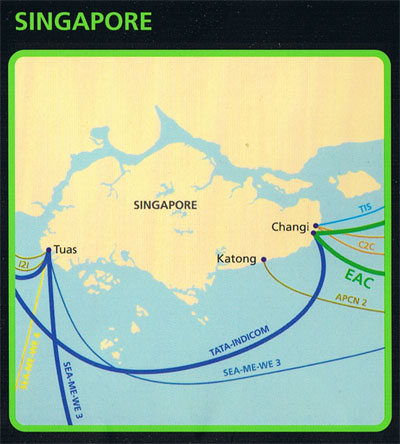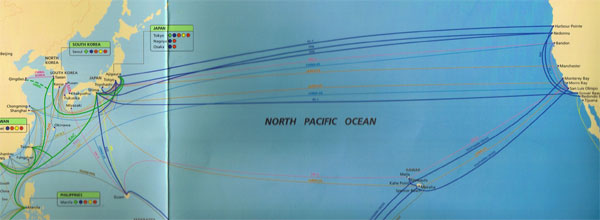 We are slowly recovering from the disaster submarine fiber cut due to the earthquake in Taiwan. It is definitely one of the worst I remember…the last time a fiber cut affect us that badly is in 1994.
We are slowly recovering from the disaster submarine fiber cut due to the earthquake in Taiwan. It is definitely one of the worst I remember…the last time a fiber cut affect us that badly is in 1994.
First, lets clarify a few misconceptions: submarine cables are not under the seabed. It is just lay across the sea. It is only when it crosses major shipping lines and fishing zones (mostly near the coast) that it is lay (5 to 10m below) under the seabed. Therefore, it is not unusual for submarine cable to be cut, mostly due to deepsea fishing.
 So when one submarine cable is severed, the operator generally have “restoration”, either on their own (self-healing cables) or using their competitors cables. This minimized the disruption. What is unusual is that this earthquake in Taiwan sever all the major cables (see above for the fibers near Taiwan).
So when one submarine cable is severed, the operator generally have “restoration”, either on their own (self-healing cables) or using their competitors cables. This minimized the disruption. What is unusual is that this earthquake in Taiwan sever all the major cables (see above for the fibers near Taiwan).
As far as reports goes, SeaMeWe-3, ACPN2, C2C and EAC (ANC) (link) are severed. In other words, all the major submarine cable at the same time. Under other circumstance, when SeaMeWe-3 cuts, we can fall back to APCN2 or C2C or EAC. But when all of them are cut at the sametime, there is really nothing to fall back upon. But how does this affects Singapore? Doesn’t Singapore has a lot of submarine fiber?
But how does this affects Singapore? Doesn’t Singapore has a lot of submarine fiber?
Indeed Singapore has: APC, APCN, APCN2, SeaMeWe-2, SeaMeWe-3, C2C, EAC2, I2I, TIS and TIC or a total capacity of 28Tbps (assuming full capacity using DWDM).
We also have two path to US, going East via the Pacific Ocean or going West via Europe through the Altantic Ocean. However, as fiber system to Europe is limited (and hence more expensive) and higher latency (about 500+ms), the normal route is to go East via the Pacific Ocean, cheaper and faster (~300ms).
In other words, we are heavily depending on the SeaMeWe-3, C2C, APCN2 and EAC to bring us to Japan before hopping to other trans-pacific submarine system like Japan-US, PC-1 or China-US (as below)

So with SeaMeWe-3, C2C, ACPN2 and EAC all severed at the same time, we are literally screwed.
Now, it is easy to say lets build more submarine fibers. It is really expensive, about US$100k/km (not US$500k/km as reported in the papers. US$500k only if you need to lay it under the seabed).
The economical way is that it transit via the North Asia (and hence picking up traffic from Japan, Hong Kong/China and Taiwan) before going on to US. Doing so means we end up going via the North Asia route, following a similar path near the zone where the earthquake hits. The “safe” way is to go to Papua New Guinea/Solomon Islands then to Hawaii to US but erm, what do you pick up at Papua New Guinea?
Even the new 20,000 km Asia-America Gateway (AAG) is likely to follow the North Asia route I suspect since the members includes AiTi (Brunei), CAT Telekom (Thailand), PLDT (Philippines), REACH (Hong Kong), StarHub (Singapore) and VNPT (Vietnam) lead by Telecom Malaysia (Malaysia).
The logical solution is to develop more submarine fibers to the west, to Europe/India and then from there across Altantic ocean so we have a loop. Believe me, IDA has competent people who already knows this (and long time ago I would say). But multi-billions dollars project is going to take time. Not to mention the challenges to lay across Straits of Malacca (another story, another day). Alt, go down to Australia and then across the Pacific to US altho going to Australia cuts through the coral rift, technical and environment-politically challenging.
What about using satellite as some angry letters in the papers suggest?
One fiber optic core at current economical technology carries 10Gbps of traffic. Using satellite, assuming the state of the art 10bit/hz, we would need to reserve 1000Mhz of channel bandwidth to match ONE core of fiber optic. Submarine fibers generally has 4-8 pairs of fiber core so do your own math. The latency for satellite is also 400-500ms per hop. To get to US, we need approximately 2 hop.
The last time we use Satellite for Internet is in 1994.